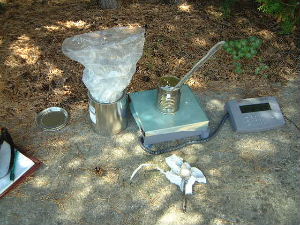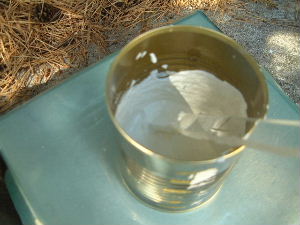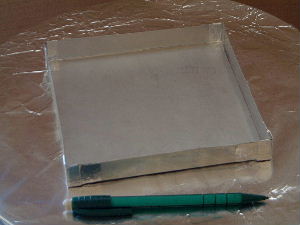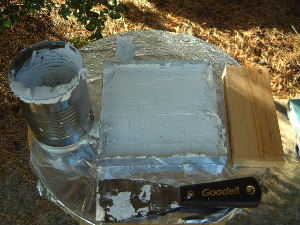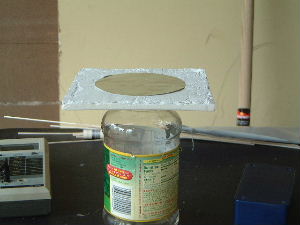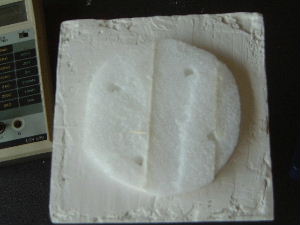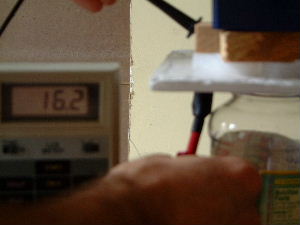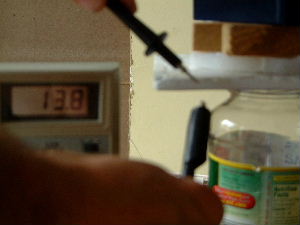This was a flat plate capacitor consisting of barium titanate (BaTiO3)
and paraffin wax. It was made at a Weird Science weekend
with friends on September 4, 2004. The K was measured using two different
instruments as either 12.5 or 18.6.
Making the barium titanate and wax dielectric
The paraffin wax was melted indoors in a can on the stove and then
brought outdoors and placed on my
digital scale for measuring the
ingredients. The barium titanate was then mixed in with the wax.
From the measurements with the scale the mix was 44% barium titanate
and 66% paraffin wax by weight.
A box mold was made using aluminium flashing and aluminium tape (both available
in hardware stores.) The mix was then scooped up from the can and placed
into the mold. The result was a nice thick paste which hardened quickly
as the wax cooled.
The dielectric constant is the ratio of the capacitance of the capacitor
with the dielectric being tested to the capacitance of the same capacitor
but with air as the dielectric.
To measure the capacitance with the dielectric, a solid round metal plate
was placed on a jar, followed by the dielectric material, followed by
a round piece of aluminium foil (see left photo below.) Then, to compress
the foil plate a piece of foam with four access holes was placed on
the foil (see right photo below.)
Weight was then placed on the foam to firmly press the whole thing together
(see photo below.) Two different meters were available to make independent
measurements of the capacitance.
Measurements were then made using the four access holes in the foam and an
average was
taken (see left photo below.) Note that this includes the capacitance of
the meter probes and the meter itself. This had to be eliminated so
an additional measurement was taken with
the meter probes spaced apart by the thickness of the dielectric but with
air between them (see right photo below.) This was to measure the capacitance
of the meter without the dielectric. This value was then subtracted from the
previously obtained average capacitance with the dieletric to get the
value for the capacitor with dielectric alone. For the two meters, the
values were 134pF and 199pF.
Next, the capacitance of the capacitor with just air as the dielectric
was needed. Rather than measuring this, it was calculated using the
normal formula for a plate capacitor giving 10.7pF.
The dielectric constant with the two different capacitors were therefore:
K1 = 134pF / 10.7pF = 12.5
K2 = 199pF / 10.7pF = 18.6
Both these were pretty respectable values given that most insulators
are in the 2 to 3 range.
Measuring the resistance of the barium titanate and wax dielectric
Just in case, we also measured resistance of the barium titanate powder
with the meter probes spaced about 2cm apart and got 4Mohms. We then
made a similiar measurement with the dielectric and got 2.31Mohms.
This was too low for our purposes.
Given that the high voltage power supply we were going to test with
could supply 80kV, we calculated the current that would go through
the dielectric as 34.6mA (80kV/2.31Mohms). We then measured the resistance
of 1/16" thick paraffin wax and got > 20Mohms.
Figuring that moisture might be the issue, we put the dielectric in the
oven at 110C (230F) for 65 minutes and measured resistance again. The
resistance of the dielectric was now > 20Mohms, so moisture was likely the
problem.
Propulsion testing of the barium titanate and wax dielectric
Applying a range of high voltages with the capacitor on a digital
scale, it showed no sign of weight change.

